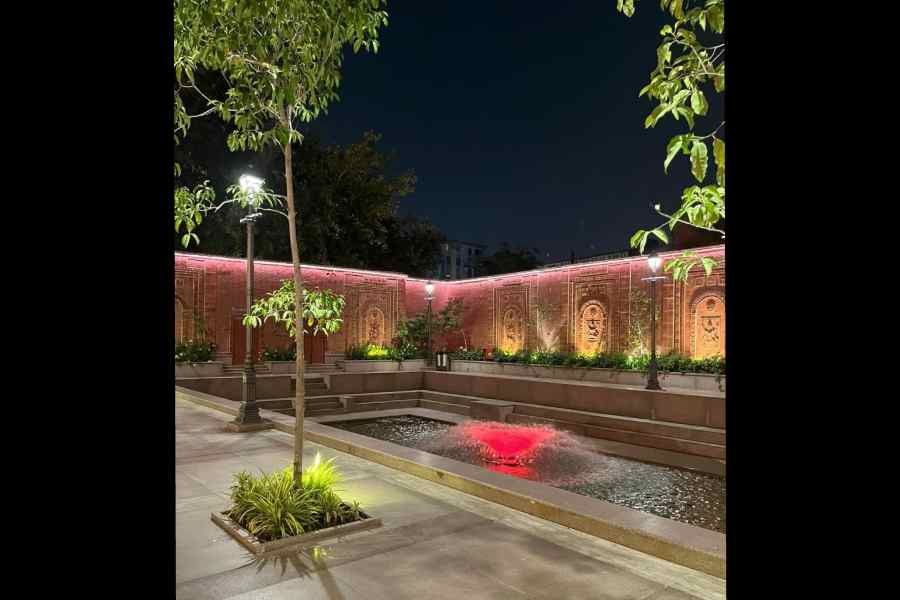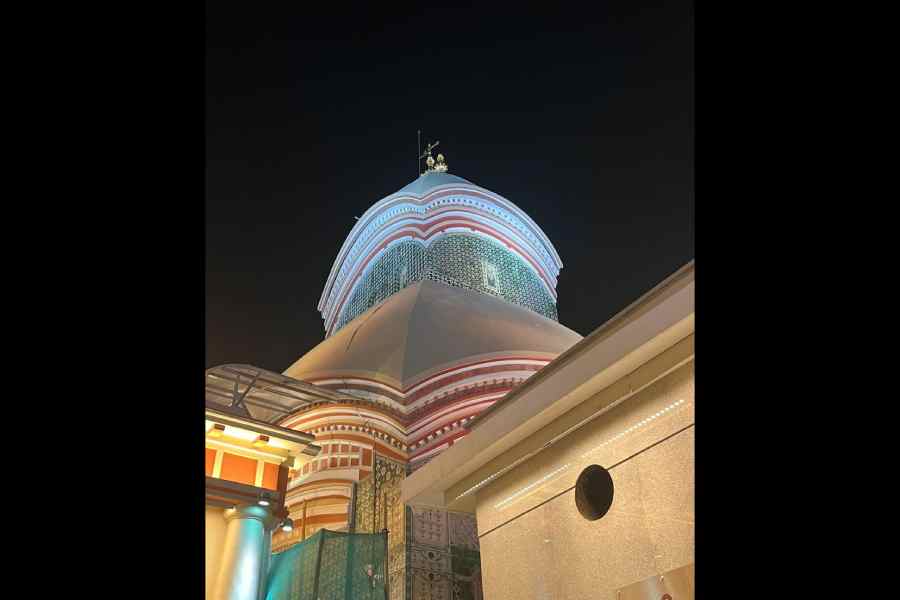After Dakshineswar, the Kalighat temple is waiting fervently for a complete makeover. It wants the skywalk leading to the Kali temple, one of the most revered places of worship in India, completed fast.
The severe disruption the construction of the skywalk is causing to local life is being tolerated because people here hope that when completed, the skywalk will be more than a fitting approach to the temple, which has got a dazzling new look.
The temple is now topped by three gold-plated pots. But some people are also hoping that the completion of the skywalk, and the new look, will get them their livelihoods back.
Rising like a giant false ceiling, the frame of the 430-metre skywalk, a Kolkata Municipal Corporation (KMC) project, is in place now. It will connect S.P. Mukherjee Road directly with the temple, one of the 51 Shakti Peethas of eastern India.
The construction of the skywalk started in October 2021. The stretch below the skywalk — previously the approach road to the temple — has been dug up entirely since then. Vehicles are not allowed here and, for pedestrians, it is a hazardous trek. Going to the temple, visited every day by thousands from Bengal and other places of India, is not easy any more.
The most affected are the vendors and stall owners whose shops, overflowing with metal lamps, images of idols, cloth and sindoor, once looked like an impenetrable fortress along the left side of the approach road, giving to the temple much of its character.
The shops on the ground floors of buildings are now obscured by the skywalk pillars; those on the pavement have been displaced. Some of the vendors are selling from the messy floor under the skywalk.
The view of residential buildings on either side of the road has been obstructed by the construction. A group of shopkeepers, the Kalighat Refugee Hawkers’ Corner, have been transferred from a nearby building to another location. They will be rehabilitated here once the skywalk is functional.

The renovated Kundapukur at Kalighat Sourced by The Telegraph
Business has suffered significantly for all. "Byabsa onek kom (business has declined)," say most of the shopkeepers. They are reluctant to be named.
Some question the wisdom of installing a skywalk here instead of improving the existing road and space. But with the Trinamool Congress’s energising performance in the Lok Sabha elections, most are looking forward to a quick, celebratory completion of the skywalk and, therefore, to relief.
The vendors selling from the ground do not know what will happen to them. “I hope Didi will rehabilitate us,” says a woman selling flowers. Kalighat is also the residential address of Didi, chief minister Mamata Banerjee.
The area is also getting used to the temple after its makeover, which is stunning.
As evening descends, the new entrance with its pillared front comes into view blazing with LEDs and rotating glow signs, and the golden temple-top seems to catch the light and shimmer. A divider sets the temple premises apart from the road and the peda shops.
Inside, new gleaming metal railings have created corridors for crowd management as strings of LEDs throw light on the recreated new tiles on the temple walls. The whole place is aglow — and a bit unrecognisable.
The KMC had begun the renovation by building a wall around the temple to separate it from the shops. Last November, Reliance Industries chairman Mukesh Ambani announced that Reliance would repair the temple, “including the centuries-old heritage structures”.
The heritage goes back a long way. The current structures are about 200 years old, but the temple was mentioned in the 15th-century text, Mansar Bhasan.
The current temple buildings were constructed by members of the Sabarna Roy Chowdhury family. The main temple is an aatchala: a traditional temple architectural form in Bengal. Aatchala means eight roofs: four arched roofs at two levels, the top ones smaller, descending on four sides from square bases. This shape is based on the humble mud hut of rural Bengal.
According to Kalighat legend, it is a Shakti Peetha as Sati’s right toes fell at the site of the temple when Vishnu cut up her corpse with the Sudarshan Chakra to stop Shiva’s tandav.
Shiva, carrying the corpse of Sati, his wife, on his shoulders, overcome with grief, had begun the tandav dance, which could have destroyed all creation.
Sati’s body parts were believed to have fallen into a water tank here, which came to be known as Kaku-Kunda, or Kundapukur, and was part of the temple grounds earlier. The temple took shape next to it. The water of this tank was considered sacred. Bathing in it blessed childless couples, it was believed.
The idol of the goddess is stark, beautiful and awe-inspiring. Her three eyes, like three leaves, look directly ahead as her long, golden tongue drops down from her mouth. Two of her four golden hands bear a scimitar and a severed human head, the latter symbolising the human ego slain by her, and the remaining two provide blessings and assurance.
Old terracotta work was discovered under the roofs. Artist Tamal Bhattacharya, who was drafted in for their restoration, found them in a severely damaged state.
“There were three motifs: a pair of parrots, a circular floral design, and a severed human head,” Bhattacharya says. But the terracotta could not be “restored”, he adds, as much of it was extremely damaged. The motifs were recreated.
The old tiles on the temple walls with their intricate designs, possibly imported, too were recreated, in Gujarat, and brought here, Bhattacharya says.
The temple walls, originally lime-and-mortar, were repaired with composite mortar and painted. The main temple floor was restored. Granite slabs were fixed in the peripheral areas. The older marble slabs with the names of the people who had donated them have been removed.
“We tried to keep the features of the old temple as much as possible,” says conservation architect Kalyan Chakraborty, who was put in charge of the renovation by Reliance.
Perhaps it is a new version of the old, as the three gold-plated pots, a special gift from Reliance, attest. Earlier they seemed to rise from the temple wall naturally, with the same design.
Kalighat temple now has a new grandeur that can be spotted from afar.
The most startling change can be seen in Kundapukur. Its water has been cleaned, its sides paved with granite and a fountain installed in it. It is gated and generally closed to the public, though the gates can be opened by the temple authorities. The beautification was necessary because the water, with the waste being dumped into it by the shops around it, had become unusable.
The owner of a shop opposite the entrance, where one can keep one’s shoes, points proudly at the lit-up entrance. “The temple is beautiful now; it is much cleaner,” he says.
A panda, however, quietly says that many devotees miss the earlier kunda, bathing in which would make their wishes, especially for children, come true.
And an old couple, who had to walk down a road parallel to the earlier approach road after leaving the temple to return home, say they miss the old temple.
Bengal may stand apart in national politics, but the aesthetic of its worship is changing into something else.










